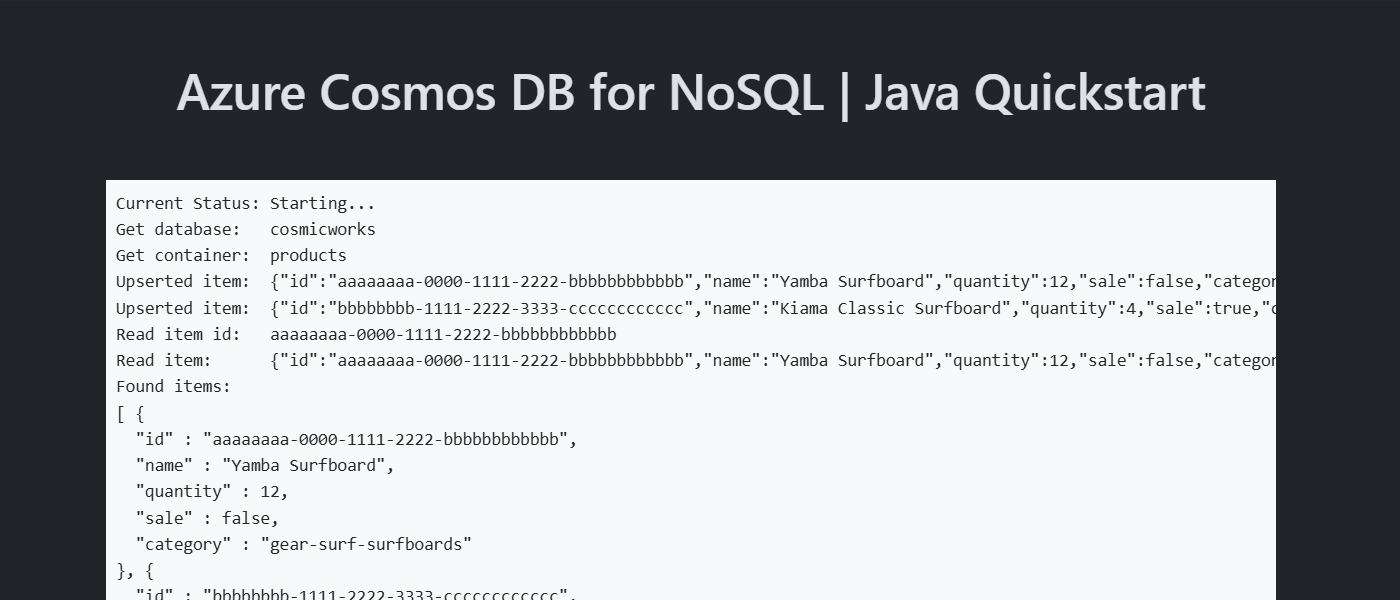Note
Access to this page requires authorization. You can try signing in or changing directories.
Access to this page requires authorization. You can try changing directories.
In this quickstart, you deploy a basic Azure Cosmos DB for Table application using the Azure SDK for Java. Azure Cosmos DB for Table is a schemaless data store allowing applications to store structured table data in the cloud. You learn how to create tables, rows, and perform basic tasks within your Azure Cosmos DB resource using the Azure SDK for Java.
API reference documentation | Library source code | Package (Maven) | Azure Developer CLI
Prerequisites
- Azure Developer CLI
- Docker Desktop
- Java 21
If you don't have an Azure account, create a Trial before you begin.
Initialize the project
Use the Azure Developer CLI (azd) to create an Azure Cosmos DB for Table account and deploy a containerized sample application. The sample application uses the client library to manage, create, read, and query sample data.
Open a terminal in an empty directory.
If you're not already authenticated, authenticate to the Azure Developer CLI using
azd auth login. Follow the steps specified by the tool to authenticate to the CLI using your preferred Azure credentials.azd auth loginUse
azd initto initialize the project.azd init --template cosmos-db-table-java-quickstartDuring initialization, configure a unique environment name.
Deploy the Azure Cosmos DB account using
azd up. The Bicep templates also deploy a sample web application.azd upDuring the provisioning process, select your subscription, desired location, and target resource group. Wait for the provisioning process to complete. The process can take approximately five minutes.
Once the provisioning of your Azure resources is done, a URL to the running web application is included in the output.
Deploying services (azd deploy) (✓) Done: Deploying service web - Endpoint: <https://[container-app-sub-domain].azurecontainerapps.io> SUCCESS: Your application was provisioned and deployed to Azure in 5 minutes 0 seconds.Use the URL in the console to navigate to your web application in the browser. Observe the output of the running app.

Install the client library
The client library is available through Maven, as the azure-data-tables package.
Navigate to the
/src/webfolder and open the pom.xml file.cd ./srcIf it doesn't already exist, add an entry for the
azure-data-tablespackage.<dependency> <groupId>com.azure</groupId> <artifactId>azure-data-tables</artifactId> </dependency>
Import libraries
Import all of the required namespaces into your application code.
import com.azure.core.http.rest.PagedFlux;
import com.azure.data.tables.TableAsyncClient;
import com.azure.data.tables.TableClientBuilder;
import com.azure.data.tables.models.ListEntitiesOptions;
import com.azure.data.tables.models.TableEntity;
import com.azure.identity.DefaultAzureCredential;
import com.azure.identity.DefaultAzureCredentialBuilder;
Object model
| Name | Description |
|---|---|
TableServiceAsyncClient |
This type is the primary client type and is used to manage account-wide metadata or databases. |
TableAsyncClient |
This type represents the client for a table within the account. |
Code examples
The sample code in the template uses a table named cosmicworks-products. The cosmicworks-products table contains details such as name, category, quantity, price, a unique identifier, and a sale flag for each product. The container uses a unique identifier* as the row key and category as a partition key.
Authenticate the client
This sample creates a new instance of the TableServiceAsyncClient class.
DefaultAzureCredential azureTokenCredential = new DefaultAzureCredentialBuilder()
.build();
TableServiceAsyncClient client = new TableServiceClientBuilder()
.endpoint("<azure-cosmos-db-table-account-endpoint>")
.credential(credential)
.buildAsyncClient();
Get a table
This sample creates an instance of the TableAsyncClient class using the GetTableClient method of the TableServiceClient class.
TableAsyncClient table = client
.getTableClient("<azure-cosmos-db-table-name>");
Create an entity
The easiest way to create a new entity in a table is to use createEntity.
String rowKey = "aaaaaaaa-0000-1111-2222-bbbbbbbbbbbb";
String partitionKey = "gear-surf-surfboards";
TableEntity entity = new TableEntity(partitionKey, rowKey)
.addProperty("Name", "Yamba Surfboard")
.addProperty("Quantity", 12)
.addProperty("Price", 850.00)
.addProperty("Sale", false);
Create an entity in the collection using upsertEntity.
Mono<Void> response = table.upsertEntity(entity);
Get an entity
You can retrieve a specific entity from a table using getEntity.
String rowKey = "aaaaaaaa-0000-1111-2222-bbbbbbbbbbbb";
String partitionKey = "gear-surf-surfboards";
TableEntity entity = table.getEntity(partitionKey, rowKey);
Query entities
After you insert an entity, you can also run a query to get all entities that match a specific filter by using listEntities and the ListEntitiesOptions class. Use the setFilter method to specify a string OData filter.
ListEntitiesOptions options = new ListEntitiesOptions()
.setFilter("PartitionKey eq 'gear-surf-surfboards'");
PagedFlux<TableEntity> tableEntities = table.listEntities(options, null, null);
Parse the paginated results of the query by using a subscription.
tableEntities
.DoOnNext(entity -> {
// Do something
});
Clean up resources
When you no longer need the sample application or resources, remove the corresponding deployment and all resources.
azd down